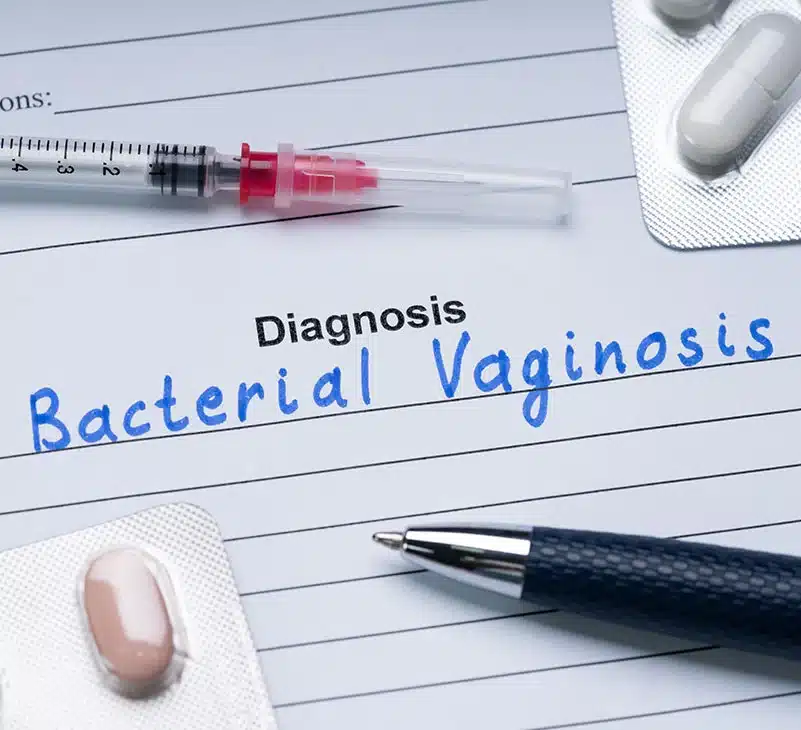This article is reviewed by Dr. Harimohan Chandola

Bacterial vaginosis is a common vaginal condition that occurs due to an imbalance in the vaginal microbiota, characterized by an overgrowth of harmful bacteria [1]. While modern medicine offers effective treatments, Ayurveda, the ancient holistic healing system of India, also provides valuable insights into managing the condition. Ayurveda focuses on restoring balance in the body through personalised treatments and lifestyle modifications. So, without further ado, let’s dive right into it.
The Most Common Symptoms of Bacterial Vaginosis
Bacterial Vaginosis often presents with a combination of the following symptoms [1]
- Unusual vaginal discharge: Thin, greyish-white discharge with a distinct fishy odour, especially after sexual intercourse.
- Itching or irritation: Some women may experience itching or irritation around the vaginal area.
- Burning sensation: Bacterial Vaginosis may cause a burning sensation during urination.
- Vaginal discomfort: Women with Bacterial Vaginosis may experience mild to moderate vaginal discomfort or pain.
Ayurvedic Perspective on Bacterial Vaginosis Causes
Vaginitis arises from an imbalance in the normal vaginal defence mechanisms, including vaginal flora (Lactobacilli), vaginal pH, and the vaginal squamous epithelial layer. The condition can be broadly categorised into two types: Infectious and Non-infectious [2].
Bacterial Vaginosis falls under infectious Vaginitis and is identifiable by a distinct white or grey milky discharge with a foul smell and a vaginal pH exceeding 4.5. This condition has been associated with significant Obstetric and Gynecologic complications, including preterm labour or delivery, premature rupture of membranes, spontaneous abortion, and post-caesarean delivery wound infections, along with post-abortal endometritis [2].
In the Ayurvedic perspective, Bacterial Vaginosis may be correlated with Sannipatik Yonivyapada, one of the Vimshati Yonivyapada (twenty disorders of Yoni). Various factors such as abnormal dietary habits, lifestyle choices, hormonal imbalances (Artava), and abnormalities of Beeja (reproductive elements) are considered as causative factors for these disorders [2].
Abnormal mode of life includes practices like repeated douching, use of tight clothing, and exposure to chemicals in scented tampons, birth control pills, and smoking. Hypoestrogenism is also recognized as a significant contributor to Vaginitis [2].
Bacterial Vaginosis Diagnosis
In Ayurveda, a skilled practitioner will diagnose Bacterial Vaginosis based on a comprehensive assessment of the patient’s medical history, lifestyle, and physical examination.
Ayurvedic diagnosis aims to identify the Dosha imbalance and the root cause of the condition. The physician may also use specific Ayurvedic diagnostic techniques, such as Nadi Pariksha (pulse diagnosis) and Jihva Pariksha (tongue examination), to gain deeper insights into the patient’s health [2].
Your doctor may also look for additional signs such as [2]:
- Presence of homogenous thin vaginal fluid that adheres to the vaginal walls.
- Vaginal fluid pH greater than 4.5.
- A positive ‘Whiff test,’ which involves the release of an amine odour when 10% potassium hydroxide is added to a sample of vaginal secretions.
- Observation of ‘clue cells,’ which are vaginal epithelial cells with obscured borders due to the presence of adherent small bacteria.

Ayurvedic Treatment Approaches for Bacterial Vaginosis
Bacterial Vaginosis treatment as per Ayurveda include:
- Herbal Remedies: Ayurvedic herbs like Neem (Azadirachta indica), Guduchi (Tinospora cordifolia), and Haridra (Curcuma longa) possess potent antimicrobial and anti-inflammatory properties, which can help combat the harmful bacteria causing Bacterial Vaginosis. In traditional Ayurvedic medicine, certain medicinal plants, namely Gokshura (Tribulus terrestris), Nirgundi (Vitex negundo), Punarnava (Boerhaavia diffusa), Jatamamsi (Nardostachys jatamansi), and Gambhari (Gmelina arborea), have been utilized to address various bacterial ailments which can also help in the management of the disease [3]
- Dietary Modifications: An Ayurvedic diet emphasizes consuming warm, easily digestible, and freshly prepared foods. Avoiding cold, heavy, and oily foods can help balance the Doshas and support the healing process [2].
- Vaginal Douching: Ayurvedic practitioners may recommend specific herbal formulations for vaginal douching to maintain a healthy vaginal environment and promote healing [4].
- Panchakarma therapy: In severe cases of Bacterial Vaginosis, Panchakarma, a comprehensive Ayurvedic detoxification therapy, may be recommended to eliminate toxins and restore dosha balance [5].
The Takeaway
Ayurveda recognises the importance of restoring balance in the body, considering factors such as diet, lifestyle, and individual constitution. The Ayurvedic treatment approaches for Bacterial Vaginosis involve the use of herbal remedies, dietary modifications, lifestyle changes, and, in severe cases, Panchakarma therapy.
While Ayurveda offers valuable insights into managing the condition, it is essential to consult qualified Ayurvedic practitioners and healthcare professionals to receive personalised recommendations and ensure safe and effective treatment. Embracing the wisdom of Ayurveda can pave the way for a holistic and integrative approach to managing Bacterial Vaginosis and supporting overall health and well-being.
FAQs
Can Bacterial Vaginosis be prevented through Ayurveda?
Yes, Ayurveda offers preventive measures to reduce the risk of Bacterial Vaginosis. Practising good hygiene, following a balanced diet, managing stress, and maintaining a healthy lifestyle can help prevent Bacterial Vaginosis from occurring.
Can Ayurvedic treatments completely cure Bacterial Vaginosis?
Ayurvedic treatments can significantly improve the symptoms and help restore balance in the body. However, the efficacy of Ayurvedic treatments may vary from person to person. Complete cure depends on various factors, including the severity of the condition, adherence to the treatment plan, and individual response to therapies.
Are there any Ayurvedic herbs that can be used for vaginal steaming to alleviate Bacterial Vaginosis?
Yes, Ayurvedic practitioners may recommend certain herbs for vaginal steaming, also known as Yoni steam, to maintain a healthy vaginal environment. Commonly used herbs include Neem Haridra, Guduchi, Nirgundi, Gokshura, etc which possess antimicrobial and anti-inflammatory properties.
Can Ayurveda help prevent recurrent Bacterial Vaginosis episodes?
Ayurveda focuses on improving overall health and immune function, which may help reduce the likelihood of recurrent Bacterial Vaginosis episodes. Adopting a healthy lifestyle, practising stress management, and following Ayurvedic dietary and herbal recommendations can play a role in preventing recurrences.
Is self-medication with Ayurvedic remedies recommended for Bacterial Vaginosis?
Self-medication is not advisable for any health condition, including Bacterial Vaginosis. It is crucial to consult a qualified Ayurvedic practitioner to receive personalized recommendations based on your specific dosha imbalance and medical history.
Disclaimer: The information provided in this article is for general information only and is not intended to substitute any medical advice. It is recommended to consult your healthcare practitioner for any health advice.
References:
- https://www.ncbi.nlm.nih.gov/pmc/articles/PMC9735379/#:~:text=Bacterial%20vaginosis%20is%20mainly%20caused,are%20diagnostic%20of%20bacterial%20vaginosis.
- http://iamj.in/posts/images/upload/453_456_1.pdf
- https://assets.researchsquare.com/files/rs-1290283/v2/e01b5575-eab2-4c29-a467-f498f4f29a99.pdf?c=1648484967
- https://www.sciencedirect.com/science/article/abs/pii/S0002937807022259
- https://www.researchgate.net/profile/Punam-Sawarkar-2/publication/356782208_Management_Of_Trichomonas_Vulvovaginitis_Kaphaja_Yoni_Vyapada_In_Diabetic_Patient_-A_Case_Report/links/61ab9206092e735ae2deb01c/Management-Of-Trichomonas-Vulvovaginitis-Kaphaja-Yoni-Vyapada-In-Diabetic-Patient-A-Case-Report.pdf





















